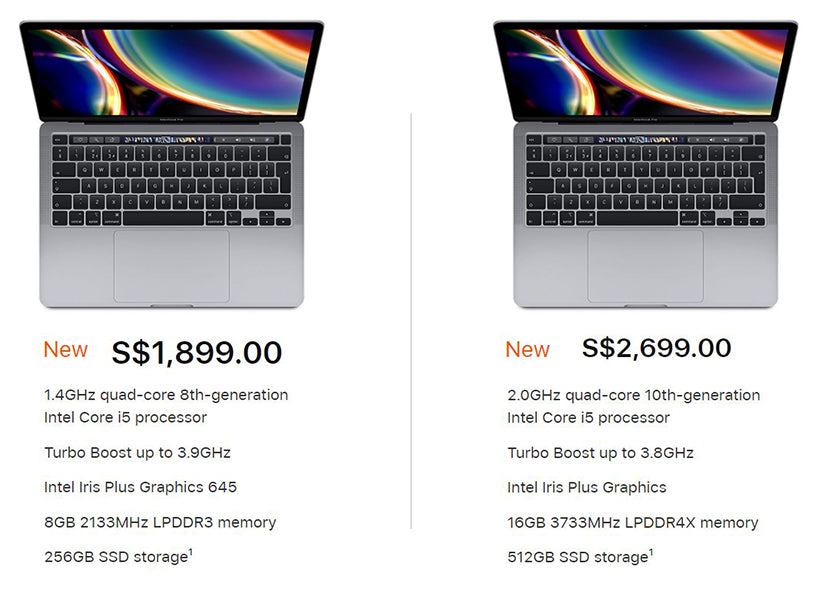
The wait is finally over. The newest MacBook Pro 2020 13-inch is in town. We will examine why it is worth the wait after looking at the main differences between the base and the high-end model.
The base model’s processor and graphics remained the same as per the 2019 base model, Intel i5 8th Generation Processor and Iris Plus Graphics 645. However, for the price of $1,899.00, the storage has doubled this year. The high-end model ($2,699.00) offers better value as it comes with the latest Intel 10th Generation Ice-Lake Processor, Iris Plus Graphics, and 2x memory and 2x storage. It used to cost $580.00 to upgrade to 16GB and 512GB for the 2019 model. Both the base model and high-end model have the P3 Retina Display, which featured True-Tone Technology and the latest Magic Keyboard. However, it is only the high-end model that supports 6K external display.
Major Upgrade 1 - New Magic Keyboard
Apple has finally reintroduced the scissor keyboard, or as Apple would like to term it, Magic Keyboard. The scissor mechanism offers more reliability, better typing experience, and has more key-travel (1mm). Thus, the new MacBook Pro 2020 is slightly thicker than its predecessor (just that little bit). With this launch, it has marked the end of the butterfly keyboard across all MacBook line-up. Some other features include a physical Escape key and an inverted-“T” arrow keys design. Well done, Apple! We have been waiting for this revert since the introduction of the butterfly keys in 2015.

Major Upgrade 2 - Intel 10th Gen Processor
The base model comes with the previous i5 8th generation processor, and the high-end model with the latest 10th generation Ice-Lake Processor. Today, we will examine the new 10th generation chip.
We are using the Geekbench 5 benchmark for CPU comparison. From the single-core results, we can see that the 10th generation chip delivered better performance despite having a lower-core and boost-clock speed as compared to the 8th generation chip found in the 2019 13-inch model. The increase in single-core performance is around 25 percent. When it comes to multi-core results, the increase in performance is less significant at about 7 percent.

Major Upgrade 3 – Intel Iris Plus Graphics
According to Apple, “The integrated Intel Iris Plus Graphics deliver up to 80 percent faster performance over the previous generation 13-inch MacBook Pro for 4K video editing, faster rendering, and smoother gameplay.”
We conducted some tests to find out more. Metal benchmark test results came back with a score of 10,149 for the high-end model and the base model at 6,840. The improvement is around 35% when compared to the 2019 high-end model. That is pretty impressive.

For the gaming performance test, we used the Unigine Heaven benchmark conducted under extreme settings. The result was constant. The high-end model came in higher with 13.4 frames per second (FPS) compared to 11.3 FPS for the previous year's model. If you're wondering which MacBook pro has the highest FPS performance, the throne belongs to the MacBook Pro 2019 16-inch model at 46 FPS.

Memory & SSD
The high-end model uses a better memory (RAM), utilizing a 3733MHz LPDDR4X memory, while the base model is running the same 2133MHz LPDDR3 memory as per the 2019 models. The newer LPDDR4X will be able to process data to the CPU at a higher rate of 29,864 MB/s instead of 17,064 MB/s. LPDDR4X also consumed less power as compared to LPDDR3. Another thing to note is that only the high-end model is configurable up to 32GB memory, while the base model offers up to 16GB memory.
Interestingly, Apple has also used a better SSD for the high-end model as compared to the base model. The high-end model's 512GB SSD has a read speed of 2,049 MB/s and a write speed of 2,309 MB/s. While the base model's 256GB SSD has a read speed of 1,751 MB/s and a write speed of 1,236 MB/s. That is almost twice the read speed found in the high-end model.
It is unclear if Apple will use the same high-performing 512GB SSD found in the high-end model if consumers opt to upgrade the base model's 256GB SSD to 512GB SSD.
The Real Question: To Get?
For the base model, I would recommend those who do not need higher graphics performance. This machine is more than capable of handling day-to-day tasks, including photo editing, video editing, and rendering, including 4K. For developers, you might want to consider upgrading it to 16GB memory (+$150.00) as the base model has a default memory of 8GB. For Gamers, this is probably not the machine for you due to the low FPS gaming performance.
The high-end model ($2,699.00) included a lot of pros this year, including the 2X memory and 2x storage, a better thermal performance due to having two fans, Intel Plus Graphics, and the new Intel 10th Generation Ice-Lake Processor. Due to the better graphics, this machine can handle some gaming with decent FPS at medium settings. In short, if you need better graphics performance and have the spare cash, go for it! It is a better buy as compared to the previous year's high-end model.
The New MacBook Pro 2020 is well-rounded, with significant performance upgrades, and more importantly, fixing the butterfly keyboard issue. All Hail The New Pro.
